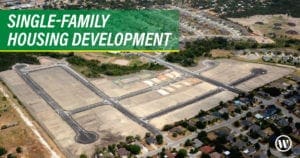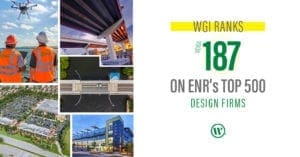
It’s a Great Time for Single-Family Housing Development in Texas
They say everything’s bigger in Texas and population growth is no exception. In part one of this series, see what you need to keep in mind when planning for current and future growth.
Learn from award-winning professionals — explore our whitepapers, blogs, and the latest industry updates.
Join our dynamic organization of engineers, land surveyors, landscape architects, environmental scientists, and architects!
Talk to a market leader today! We’ll answer any questions you have about our professional services.

The total allowable impervious cover in the City of Austin is generally determined by examining two competing regulations: the zoning ordinance and the watershed ordinance, where the more restrictive will govern.
For the most part, watershed regulations will be more restrictive than zoning regulations. In Suburban Watersheds, projects are broken out into three project categories: single-family residential, multifamily residential, and commercial, with the following impervious cover regulations:
| Land Use | Maximum Impervious Cover |
| Single Family Residential | 50% (lots >5,750 sf)
55% (lots <5,750 sf) |
| Multifamily Residential | 60% |
| Commercial | 80% |
It seems simple enough until we consider a scenario where a mixed-use building is proposed with both commercial and multifamily residential components. Austin’s Land Development Code does not offer guidance as to how to calculate our impervious cover limit, so we have to turn to the Environmental Criteria Manual (ECM) for the answer. Appendix Q-5 of the ECM provides a “simple ratio” formula to calculate impervious cover (IC) for mixed-use projects, shown below. Multifamily residential and commercial impervious cover limits are 60% and 80%, respectively.
Total IC = A*60% + B*80%
A = % of multifamily ground floor
B = % of commercial ground floor use
60% = Multifamily IC allowance
80% = Commercial IC allowance
If, for example, we have a 1-acre site where 75% of the building ground floor area is dedicated to multifamily uses and 25% of the building ground floor area is dedicated to commercial uses, the impervious cover limit will be calculated by multiplying 75% of the gross site area (0.75 acres) by 60% (the multifamily use impervious cover limit) and multiplying 25% of the gross site area (0.25 acres) by 80% (the commercial use impervious cover limit) and adding the resulting figures together:
Total IC = A*60% + B*80%
A = 0.75 ac (% multifamily ground floor use)
B = 0.25 ac (% commercial ground floor use)
Total IC = 0.75*60% + 0.25*80%
Total IC = 0.2ac + 0.45ac
Total IC = 0.65 acres
This formula allows the developer to take into account the different impervious cover limits for commercial and multifamily uses per Suburban Watershed regulations, instead of making the assumption that the more restrictive limit will apply.

WGI is a national design and professional services firm leading in technology-based solutions for the construction of public infrastructure and real estate development. At WGI, we’re providing Tomorrow’s Infrastructure Solutions Today.

They say everything’s bigger in Texas and population growth is no exception. In part one of this series, see what you need to keep in mind when planning for current and future growth.

Join WGI’s Director of Structural Engineering, Arnaud Thibonnier, PE, SE, for an in-depth introduction to the unique considerations of “high-rise” structural design.

Of all the contingencies facility owners and managers planned for in 2020, a global pandemic was probably pretty low on the list. WGI has some key strategies that facility owners and managers leverage to keep your operations functioning effectively and safely amid this global pandemic.

As you prepare your real property for development, it’s essential to understand and face the zoning, political, and unique site challenges — and create a comprehensive strategy for overcoming them.

WGI moves up 37 spots on Engineering News-Record (ENR)’s 2020 Top 500 Design Firms List.

WGI’s team of professionals provided civil engineering services for the second phase of the 13.5-mile Waterloo Greenway in downtown Austin, TX
You’ve been searching for a place like WGI. We look forward to meeting you soon.
Sign up to receive emails to hear our latest news and achievements in our monthly newsletter.
Enter your zip code, and we’ll personalize your experience with local projects, office locations, team members, and more.
WGI supports its associates with meaningful opportunities for growth, strong benefits and perks, while we work collaboratively with clients and co-consultants to shape and improve communities.






WGI is a dynamic organization with opportunities nationwide for engineers, land surveyors, landscape architects, environmental scientists, and architects.